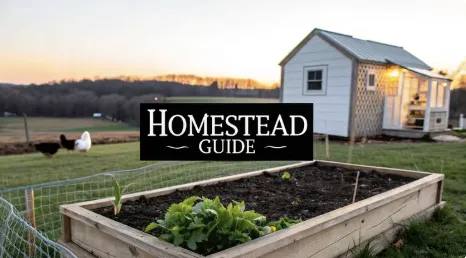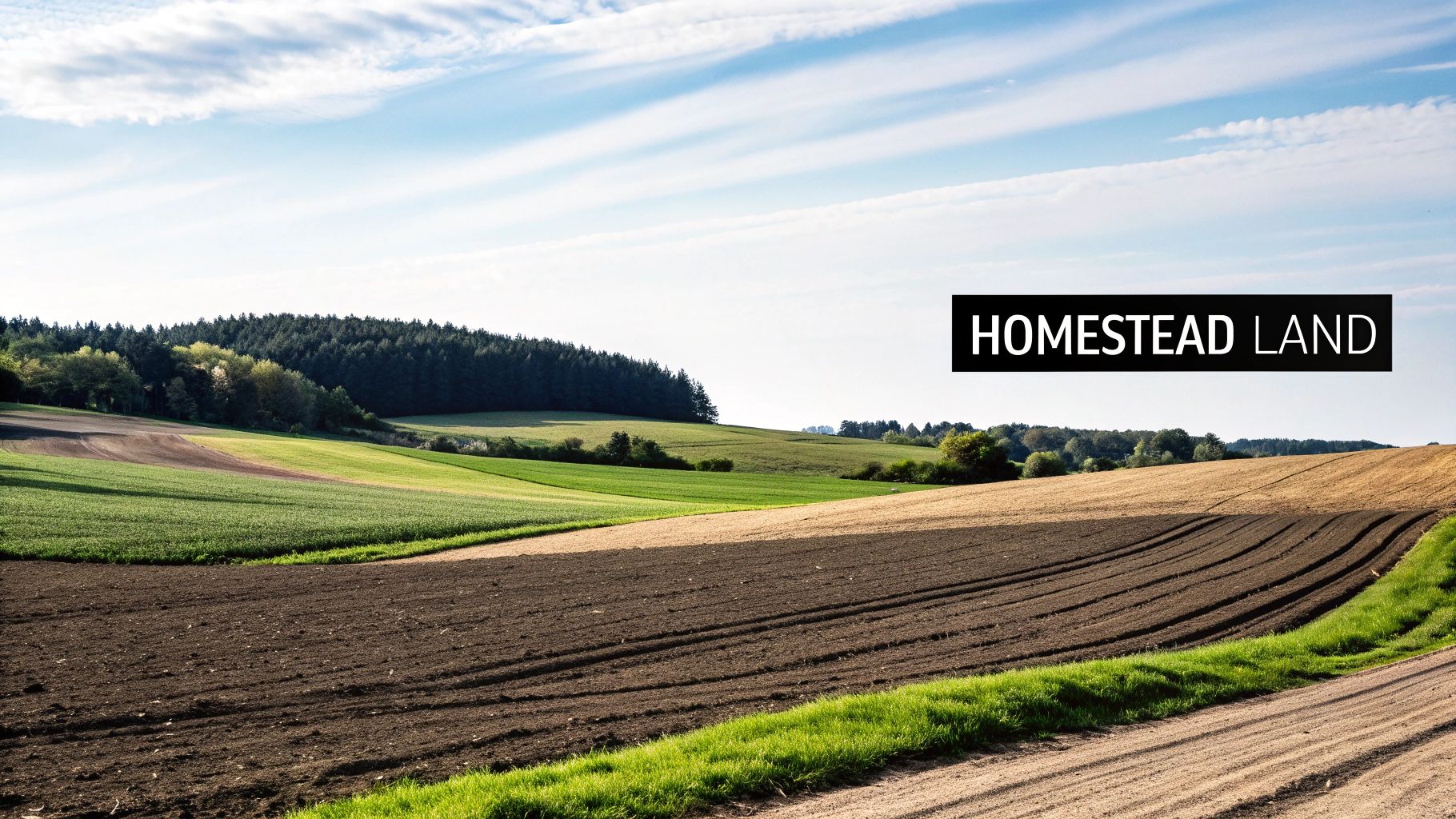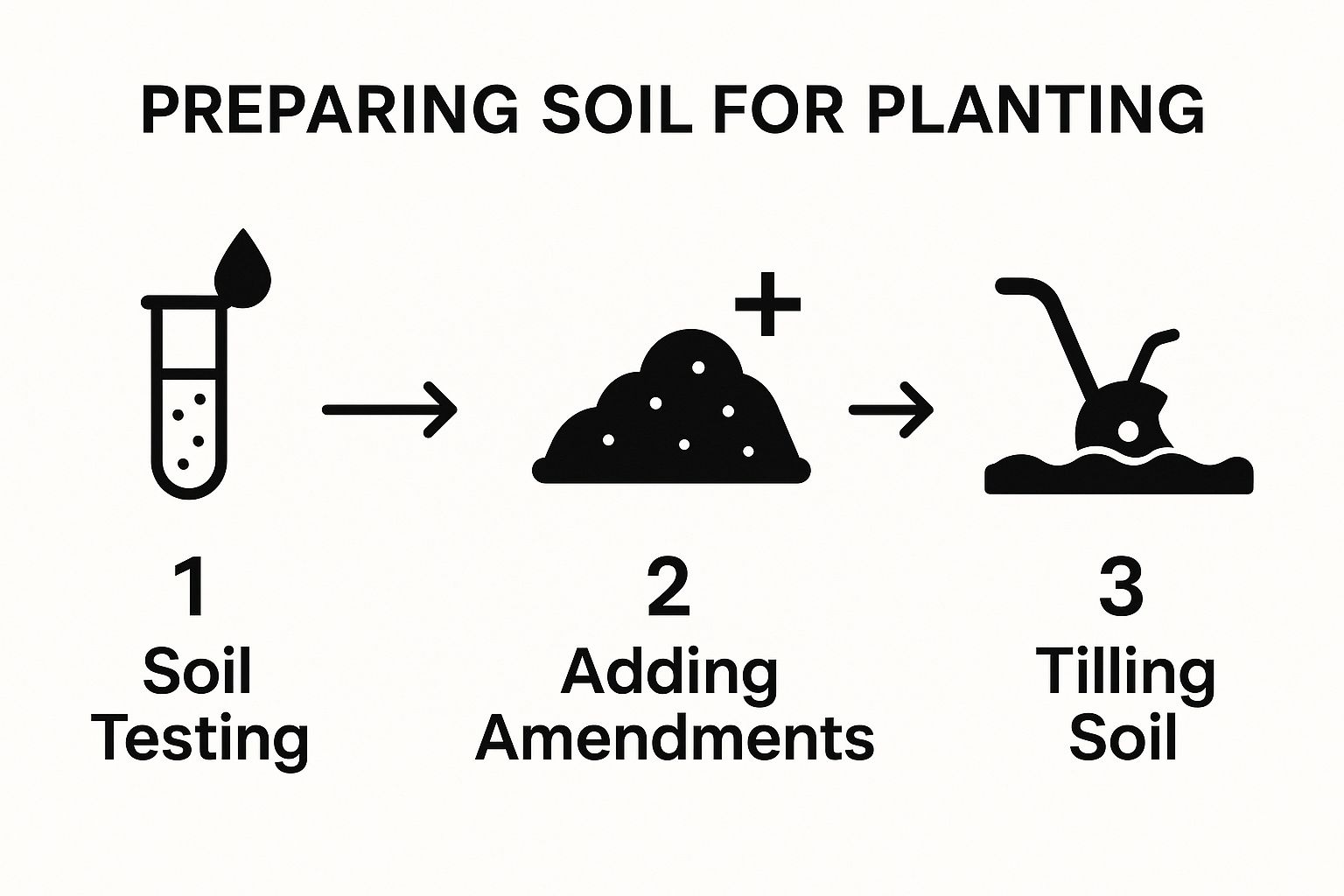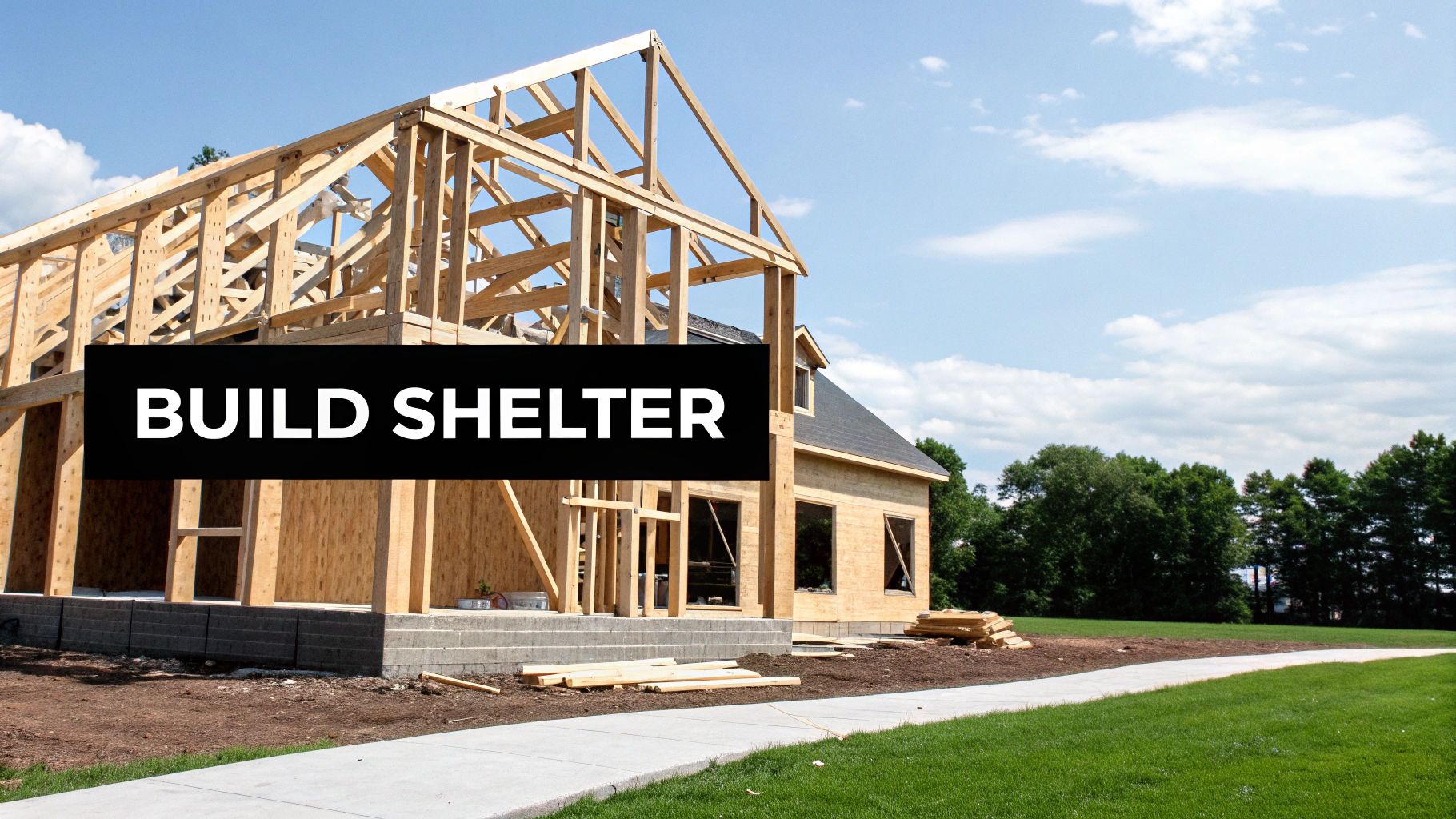
How to Homestead: A Practical First-Year Guide
How to Homestead: A Practical First-Year Guide
Learning to homestead is really about embracing self-reliance, one manageable step at a time. The journey involves picking up essential skills, starting small with something like a garden or a few chickens, and then slowly building out systems that truly fit your land and lifestyle. It’s all about steady progress, not overnight perfection.
What Modern Homesteading Really Looks Like

If you're picturing total isolation out in the wilderness, it's time for an update. Modern homesteading is a flexible, deeply practical lifestyle focused on forging a real connection to where your food, energy, and resources come from. It’s a hands-on way of living more sustainably, whether you have sprawling acreage or a standard suburban lot.
This movement is fueled by a desire for tangible benefits. For many, it's about a healthier, more transparent food source—knowing exactly what’s on your plate and how it got there. For others, it’s about gaining independence from fragile supply chains or simply shrinking their environmental footprint.
The New Face of Homesteading
The appeal of this life has exploded. Since 2000, homesteading has seen a massive resurgence, driven by a perfect storm of environmental awareness, the high cost of city living, and a collective desire for greater self-sufficiency.
This modern movement beautifully blends old-school skills with contemporary life, and it's not just for one demographic—nearly half of all homesteaders are under the age of 39.
This new wave is also breaking geographical boundaries. A growing number of urban and suburban homesteaders are cleverly adapting these principles to smaller spaces. You'll find them:
Raising backyard chickens for a constant supply of fresh eggs.
Practicing intensive urban gardening in raised beds and containers.
Installing solar panels to generate their own renewable energy.
Mastering preservation skills like canning, dehydrating, and fermenting.
The core idea is the same no matter where you live: taking active control over your own needs. It's about building a more resilient, simple, and satisfying life from the ground up.
The essence of modern homesteading isn’t about escaping society, but about actively participating in your own survival and well-being. It’s a powerful shift from being a passive consumer to becoming an active producer.
Where Do You Fit In?
The real beauty of homesteading today is that it's completely scalable. You absolutely do not need 100 acres to get started. For most people, the journey begins right in their own backyard, turning a patch of grass into a productive vegetable garden. In fact, our guide on backyard homesteading shows just how much you can accomplish on a smaller plot.
To give you a clearer picture, this table breaks down the core pillars of homesteading and suggests some very practical first projects to get you started.
Your First Steps in Homesteading

Ultimately, this is a personal journey. It's about defining what self-reliance means to you and then taking that first small, deliberate step toward your goal. It’s about the progress you make, one new skill and one finished project at a time.
Finding the Right Land for Your Homestead

When you picture your dream homestead, you probably see rolling green hills or a charming old barn. But the real heart of a successful homestead isn't what you build on it—it's the land itself. Choosing your property is the single biggest decision you’ll make, and it’s about so much more than the price tag or the acreage.
Think of your land as your most important partner. It will either work with you or fight you every single day. The right piece of ground makes growing food, raising animals, and building your home feel intuitive. The wrong one can turn every small project into a monumental, wallet-draining struggle.
Evaluating Water Sources
Water is everything on a homestead. It’s the lifeblood. Without a reliable, clean source, your garden will wither, your animals will suffer, and your dream will dry up. Don’t ever just assume a property has good water. You have to prove it.
When you’re walking a potential property, put on your detective hat. You're looking for signs of water security, both natural and man-made.
Existing Wells: If there’s a well, ask for the well log. This is a critical document showing its depth, the static water level, and the flow rate in gallons-per-minute (GPM). For a normal house, 3-5 GPM is usually fine. But for a homestead with a big garden and livestock, you’ll want more.
Natural Water Features: A year-round creek, a gushing spring, or a pond can be an incredible asset for irrigation and livestock. The key word there is year-round. A creek that looks great in April might be bone-dry by August, so ask the neighbors or check historical records to be sure.
Potential for New Sources: If there's no water source, you'll need to do some research. Are wells in the area notoriously deep and expensive? Or is the geology friendly to drilling? The cost of putting in a new well can easily hit tens of thousands of dollars, so that needs to be a major line item in your budget.
Analyzing Soil and Topography
Okay, you've confirmed there's water. The next thing to do is get your hands dirty—literally. Your soil quality will make or break your garden and pasture. You don't need perfect, loamy soil from day one, but you absolutely have to know what you're working with.
Take a walk. Look at what's already growing. A field of lush, green weeds is actually a great sign. Sparse, scrubby plants, on the other hand, can be a red flag for poor, rocky, or heavily compacted soil. The only way to know for sure is to test it. If you want to get a solid understanding of this process, this guide on soil testing at home breaks it down perfectly.
The lay of the land, its topography, is just as crucial. A property that’s perfectly flat might seem ideal, but it can turn into a swampy mess with drainage problems. On the flip side, a steep, hilly plot can be a nightmare for building and lead to serious erosion. What you really want is a little variety: some gentle slopes for good drainage, a few flat spots for your house and garden, and maybe a wooded area for firewood and wildlife.
A property with varied topography offers more options. A south-facing slope is perfect for a garden or orchard, catching maximum sunlight, while a low-lying area might be ideal for a pond.
Investigating Local Regulations
Finally, before you get too attached to a piece of land, you have to investigate the invisible fences: zoning laws, covenants, and local ordinances. These rules can absolutely torpedo your homesteading plans. It’s devastating to buy your dream spot only to find out you can’t have chickens or build a workshop.
Head down to the local county planning and zoning office and ask some direct questions:
What is the property’s official zoning (e.g., agricultural, rural residential)?
Are there limits on the number or type of animals you can keep?
What are the rules for putting up outbuildings, fences, or even a small farm stand?
Are there any easements on the property that give someone else the right to cross or use your land?
Don’t just take the real estate agent's word for it. Verify everything yourself. Taking the time to dig into the details—water, soil, topography, and rules—is the homework that separates a wishful dream from a thriving, real-life homestead.
Growing and Raising Your Own Food
Getting your hands dirty and producing your own food is, for many, the very heart of homesteading. It’s where you build a real connection to your land, and honestly, it’s the most rewarding part of this entire lifestyle. The great thing is, you don’t need a lifetime of farming under your belt to get going. All you need is a smart plan and the desire to learn as you go.
For almost everyone, that journey starts with a garden. This is your first real lesson in the rhythm of the seasons—the magic of watching a tiny seed turn into something you can put on your dinner plate. Even a small plot can make a huge dent in your grocery bill and give you produce with flavor you just can't buy at the store.
Your First Garden: Where to Begin
Before you even think about grabbing a shovel, pause and make a plan. The classic rookie mistake is going way too big, way too fast. That giant tilled plot you’re dreaming of can quickly become a weed-infested nightmare that just drains your motivation. Trust me, it’s much better to master a small, well-tended space first.
Two of the most popular methods for beginners are no-dig beds and traditional tilling.
No-Dig Gardening: This is a fantastic technique where you layer cardboard, compost, and mulch right on top of the grass. It smothers weeds, builds incredible soil over time, and saves your back. If you’re dealing with poor or compacted clay soil, this is definitely the way to go.
Traditional Tilling: This involves using a rototiller or a good old-fashioned shovel to break up the existing soil. It’s a faster way to get a bed ready for planting, but it can mess with the soil structure and dredge up a ton of dormant weed seeds. It works best if your soil is already in decent shape.
For most folks just starting out, a couple of raised beds or a small no-dig plot around 10x10 feet is perfect. It’s big enough to grow a decent amount of food but small enough that you can actually manage it while you're learning the ropes.
Planning for a Year-Round Harvest
A truly successful garden isn't just about a glut of summer tomatoes. With a little forethought, you can be pulling food out of the ground for most of the year. This all comes down to picking the right seeds and using a few simple planting strategies.
Succession planting is a game-changer. It’s just the simple act of putting a new crop in the spot where another one just finished. For example, once you harvest your spring radishes, that space is immediately ready for some heat-loving beans. No wasted time, no wasted space.
Companion planting is another powerful tool—an old-school technique of growing certain plants together because they help each other out. Planting basil next to your tomatoes can help keep tomato hornworms away, and marigolds are famous for repelling all sorts of pests in the garden.
Starting a garden is more than just a hobby; it's a growing movement. By 2025, it's estimated that around 55% of U.S. households will have a garden. Not only that, but a well-kept garden can potentially boost a property's value by 10% to 20%.
If you want to go deeper on setting up your first plot, our guide on homestead gardening for beginners lays out a fantastic roadmap.

This simple visual shows the three key steps to getting your soil ready. It really drives home the point that amazing results start with understanding what your soil needs long before you plant a single seed.
Introducing Your First Livestock: Chickens
Once your garden is up and running, adding small livestock is the natural next step. For 99% of homesteaders, the first animal through the gate should be the chicken. They’re relatively cheap, surprisingly easy to manage, and give you an immediate return on your investment: fresh, delicious eggs.
But before you bring home a box of peeping chicks, you have to get their home ready. A solid coop has a few features that are absolutely non-negotiable.
Predator-Proofing: Your coop needs to be a fortress against raccoons, hawks, and even the neighbor’s dog. This means using hardware cloth on all openings, not flimsy chicken wire.
Ventilation: Good airflow is critical for preventing respiratory problems. You want vents up high, well above the roosting bars, to let ammonia and moisture escape.
Roosting Bars: Chickens sleep on perches, not on the floor. Plan for about 8-10 inches of roosting space per bird.
Nesting Boxes: You'll need one nesting box for every 3-4 hens. Make them dark, quiet, and private—a place they feel safe laying their eggs.
One of the most important lessons in animal husbandry is this: an ounce of prevention is worth a pound of cure. A clean coop, fresh water, and quality feed will prevent the vast majority of health problems you might encounter.
The daily routine is simple and grounding. In the morning, you let them out, top off their food and water, and give them a quick once-over. In the evening, you collect the eggs and lock them up safe and sound. This little ritual connects you to your food in a way that picking up a carton at the supermarket never will.
Starting with a small flock of 3-5 hens is plenty to get a steady supply of eggs for your family and teach you the basics of livestock care without feeling completely overwhelming.
Building Your Homestead Infrastructure

A homestead that actually works runs on more than just elbow grease and decent soil. It’s held together by its infrastructure—the practical, unglamorous systems that provide water, shelter, and power. Think of it as the skeleton that supports everything you're trying to build. Without it, your best efforts are going to hit a wall, fast.
Putting these core systems in place doesn't have to break the bank or require an engineering degree. It's really about making smart, strategic choices that solve today's problems while giving you room to expand later. Every piece you add, from securing your water to keeping your tools dry, is a solid step toward real self-reliance.
Mastering Your Water Systems
Let's be clear: reliable water is non-negotiable. Your approach here is going to depend entirely on what your property offers. If you have a well, you’ve already won half the battle. But just having the well isn’t enough; you’ve got to get that water where it needs to go.
This is where you'll need to learn about essential water pumps to distribute water to the house, garden, and any livestock. A simple submersible pump might be all you need to start, but that one piece of equipment is the heart of your entire water network.
For many homesteaders, a rainwater catchment system is a fantastic, low-cost way to supplement the well. A basic setup is as simple as running gutters on a shed or coop roof that feed into a large barrel or tote. This "free" water is perfect for the garden and takes a lot of pressure off your well during the dry season.
It's amazing how much you can collect. A single inch of rain falling on a 1,000-square-foot roof can yield over 600 gallons of water. That’s a huge resource you can capture with a minimal investment in gutters and barrels.
Sheltering Your Homestead Assets
On a homestead, "shelter" means a lot more than just your house. Your tools, animals, and supplies all need protection from the elements to stay useful and healthy. This is where smart, simple structures become your best friends.
A chicken coop is often the first animal shelter people build. It doesn't need to be a palace, but it absolutely must be predator-proof and have good ventilation. You can cut costs dramatically by using reclaimed pallets for the frame or salvaged tin for the roof.
The same thinking applies to your tools. A basic lean-to shed built against an existing wall can keep your tiller and shovels from rusting away. For the garden, a small hoop house made from PVC pipe and plastic sheeting can stretch your growing season by weeks, giving you a jump on spring planting and letting you harvest greens deep into the fall.
Starting with Sustainable Energy
The thought of going completely off-grid can be overwhelming. But here's the secret: you don't start there. You start with one small, manageable step. You don't need a roof plastered with solar panels to begin using the sun's power. A small, scalable solar setup is the perfect way to get your feet wet.
Think about a simple starter kit. These usually come with a panel or two, a charge controller, a battery, and an inverter. It’s surprising what a small system like this can handle.
Light up a shed or chicken coop. This is a game-changer in the winter for extending laying hours.
Power an automatic gate opener. It's a huge convenience and adds security without the hassle of running buried electrical lines.
Charge your cordless tool batteries. You can keep your drills and saws powered up right where you’re working.
This first setup does more than just power a few lights; it teaches you the fundamentals. You'll learn how to position panels for the best sun, how to manage your battery, and how your energy use fluctuates. Once you’ve got the hang of it, you can easily add more panels and batteries as your needs grow, building on what you already know. It’s a gradual, affordable approach that makes energy independence feel achievable.
Learning the Skills for Self-Sufficient Living
Homesteading is an active, hands-on life. It's built as much on your skills as it is on your soil. While a thriving garden and healthy livestock are the foundation, true self-reliance comes from knowing what to do with that bounty and how to fix the systems that support your life. Gaining these practical skills is what truly transforms a piece of land into a resilient homestead.
The journey usually starts in the kitchen, right as your first real harvest starts pouring in. You’ll quickly find yourself with way more zucchini or tomatoes than you can possibly eat fresh. This is where food preservation becomes your best friend, turning the fleeting abundance of summer into food on your shelf for the rest of the year.
Mastering Food Preservation
Learning to "put up" your own food is a total game-changer. It’s the art of locking in flavor and nutrition so you can enjoy your garden’s best in the dead of winter. Each method has its own place in your preservation arsenal.
Water Bath Canning: This is the perfect place to start. If you’re making pickles, jams, jellies, or preserving most fruits and tomatoes, this simple method of processing jars in boiling water is safe and incredibly effective.
Pressure Canning: For low-acid foods like green beans, carrots, meats, and soups, a pressure canner is non-negotiable. It hits temperatures far hotter than boiling water, which is the only way to eliminate the risk of botulism.
Dehydrating: This is a wonderfully simple way to preserve herbs, fruits, and even make your own jerky. A good dehydrator is a worthwhile investment, concentrating flavors and creating shelf-stable snacks with minimal effort.
Fermenting: This ancient practice uses beneficial bacteria to preserve food, creating probiotic-rich staples like sauerkraut, kimchi, and sourdough bread. It’s a low-energy method that adds amazing, complex flavors and even improves digestibility.
Don't feel discouraged if you aren't feeding your family entirely from your land right away. A recent survey of 750 new homesteads found that 80% were producing 25% or less of their own food. The average was just 7% of their monthly meals. These numbers show just how critical preservation is—it lets you make the most of every single thing you manage to grow.
Essential Hands-On Repair and Building Skills
Outside the kitchen, basic workshop skills will save you an unbelievable amount of time, money, and headaches. A resilient homestead is one where you can fix what’s broken and build what’s needed without calling a professional for every little thing.
You don't need to become a master carpenter overnight. Just start with the basics. Get comfortable and safe using a power drill, a circular saw, and a good set of hand tools. With just these fundamentals, you can tackle a huge range of necessary projects.
Building simple raised garden beds.
Repairing a broken fence post.
Constructing a basic chicken roost or nesting box.
Sharpening your own garden tools.
Every small project you finish builds both your confidence and your skill set. The ability to look at a sagging gate or a leaky gutter and know you have the tools and knowledge to fix it yourself is a powerful kind of freedom. For homesteaders aiming for the highest level of self-reliance, understanding how to implement solar power for off-grid living is another crucial skill, extending your independence into your energy systems.
One of the most freeing moments on a homestead is realizing you can build the solution to your own problem. That simple tool shed you build yourself is more than just storage; it's a testament to your growing capability.
Practical Financial Planning for Homesteaders
Finally, a truly sustainable homestead has to be financially sound. Self-sufficiency isn’t just about food and tools; it’s also about managing your money wisely. Homestead finances have a totally different rhythm than a typical household budget, with big seasonal costs and unique opportunities.
Budgeting for these seasonal swings is critical. You might have large expenses in the spring for seeds, soil amendments, and new chicks. In the fall, you might be buying canning supplies or lumber for winter projects. Tracking these costs helps you plan ahead and avoid getting caught off guard.
Many homesteaders also find small ways to bring in a little income from their land. This doesn't have to be a full-scale business, but a few small income streams can make a real difference. Think about selling surplus eggs from a farm stand, offering extra veggie starts to neighbors, or turning one of your unique skills into a small side hustle. This practical approach to finances is a key part of making the homesteading life work for the long haul.
A Few Common Questions About Getting Started
Diving into homesteading always kicks up a storm of questions. It's totally normal to feel that mix of pure excitement and a little bit of "what have I gotten myself into?" Let's clear the air and tackle some of the biggest questions people have right before they take the leap.
How Much Land Do I Really Need?
This is the big one, and the answer is simpler than you think: it all comes down to your goals, not some magic number. You can get a fantastic start and learn the core skills on a standard quarter-acre suburban lot. Seriously. A killer garden and a few chickens (if your town allows it) can teach you more than you can imagine without the stress of managing a huge property.
When you start dreaming bigger, like feeding your family most of their veggies and raising small livestock like meat rabbits or a decent-sized flock of chickens, then 2-5 acres is a great sweet spot. That gives you enough room to spread out with a large garden, a dedicated spot for animals, and maybe even a small orchard, all without it becoming a full-time job just to mow the grass.
It's only when you get into things like a family milk cow, a small herd of goats, or wanting to grow your own hay that you should even begin looking at properties of 10 acres or more.
My best advice? Start with what you can truly manage today. It's a thousand times better to master a small piece of land and use every square inch of it than to be completely overwhelmed and burned out by too much property you can't keep up with.
Is It Possible to Homestead with a Full-Time Job?
Yes, and honestly, this is how most of us start. The romantic notion of quitting your job and moving to a farm overnight is mostly a fantasy. That off-farm income is what makes the whole thing possible in the beginning.
The trick is to be smart about your setup. Design your homestead for efficiency from day one.
A few raised garden beds with a simple drip irrigation timer can handle the watering for you.
An automatic door opener on the chicken coop means you don't have to rush out at sunrise.
Focus on perennial plants—think fruit trees and berry bushes—that don't need to be replanted every single year.
Think of your job not as a burden, but as the engine that funds your dream. It pays for the tools and infrastructure that save you time and sweat down the road, allowing you to ease into this lifestyle instead of taking a massive, risky gamble.
What's the Biggest Mistake Beginners Make?
Without a doubt, it's trying to do everything all at once. That first spring, the temptation is huge: you want the giant garden, the chickens, the goats, the beehive, and you're going to learn to can it all. I see it time and time again, and it almost always ends in burnout, half-finished projects, and feeling like a failure.
A much better way forward is to master one new thing each year.
Year One: Make it all about the garden. Learn your soil, figure out your climate, and just focus on getting one really good growing season under your belt.
Year Two: The garden's humming along, so now's the time to bring in chickens. You can give them the attention they need, build a solid coop, and learn the rhythm of caring for animals.
Year Three: Okay, maybe now you can plant that small orchard you've been dreaming of or dive deep into learning food preservation.
By stacking your skills one year at a time, you build on a foundation of success. It keeps you from getting buried and ensures every part of your homestead is solid before you add something new.
How Do Homesteaders Make Money?
Not everyone sets out to turn their homestead into a business, but it's amazing how a productive piece of land can create opportunities. The most successful folks I've seen don't try to become a massive farm; instead, they build several small, diverse streams of income.
A simple roadside stand or a table at the local farmers' market is the classic way to start—selling extra eggs, whatever's abundant in the garden, or some fresh-cut flowers. Others get more creative by turning their harvest into value-added products.
Jams, jellies, and artisan pickles
Handmade goat milk soap or herbal salves
A "bread CSA" with fresh sourdough loaves
Selling high-quality breeding stock from your animals
I've also seen people teach workshops on skills they've mastered, like cheesemaking or raising chickens. The key is finding a niche that blends what you're good at with what your land naturally provides. It can create a small but really meaningful income that helps support the lifestyle you love.
At The Grounded Homestead, we believe that anyone can start this journey. For more tips, guides, and a weekly dose of inspiration delivered straight to your inbox, sign up for our "Garden Notes" newsletter. Let's grow together. Find out more at https://thegroundedhomestead.com.


Facebook
Instagram
X
Youtube